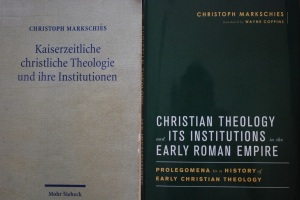As a way of wishing Bill Heroman a happy birthday, this post will focus on a topic that he has discussed at length, namely the so-called “Great Man Theory.” I’ve chosen to combine the perspectives of Heroman and Markschies, because I think they approach the topic from two fascinating angles. Neither wishes to defend this rightly discredited theory of course but rather to enable us to think about it more precisely. In short, Heroman unpacks its mnemonic advantages, while Markschies shows how its emphasis on the role played by talented individuals contains an element of truth when considered in relation to the dynamics of institutionalization. Let me give a sense of each of their contributions by including several key quotations from Heroman’s multi-part blog series on “Heroic Histories” (see 1, 2, 3, 4, 5, 6, recap of 1-6, 7) and a single quotation from Markschies’s book Christian Theology and its Institutions in the Early Roman Empire.
Key Quotations from Heroman:
Heroic Histories, 1: From a reception standpoint, therefore, while the so-called “great man theory” (henceforth a.k.a. “the hero-centered view of history”, or “the hero-driven theory of history”, or for short perhaps just “heroic history”) remains impossible to defend as either objective or accurate, it has nevertheless gone deeply under-appreciated by professional historians, who should at least feel duty-bound to explain its perennial appeal. Most importantly, we may have all overlooked the mnemonic advantages heroic histories provide in their oversimplifications.
Heroic Histories, 6: The primary advantage of Biography, for delivering rememberable story-structure, is that the ultimate human contingencies (birth & death) guarantee the reader a stable continuity in discourse, with both consistent orientation on a single subject (stable content) and an implicitly overarching chronological timeline (stable structure). That’s why a comprehensive life story’s fabula/discourse dynamic is unique among narrative genres and styles.
Heroic Histories Recap: So far, this series has made two major points. First, Heroic History is a common literary tactic because it offers significant mnemonic advantages for remembering the past. But second – and perhaps more importantly – Plot isn’t everything. Memorable stories also cohere strongly around Character.
Key Quotation from Markschies (English and German):
CTaiI (p. 26): Thus, when the term “Institution” is used to consider not only the hierarchically structured majority church but first and foremost all social structures that establish stability and duration, then the focus on the “great men”—which characterizes the traditional writing of church history and is [often] so problematic from an epistemic methodological perspective—obtains a good sense as well: institutionalization can only succeed when, in addition to a new idea, there are also “talented individuals” who endeavor to obtain a social basis for its establishment. Whether we know all these individuals and whether they were only male is naturally a completely different question that is also difficult to answer for the second and third centuries.
KCTuiI (p. 37): Wenn also mit dem Terminus “Institution” hier nicht nur die hierarchisch strukturierte christliche Mehrheitskirche in den Blick genommen werden soll, sondern zunächst einmal alle sozialen Gebilde, die Stabilität und Dauer etablieren, dann bekommt auch der wissenschaftsmethodisch oft so problematische Blick auf die “großen Männer”, der traditionelle Kirchengeschichtsschreibung prägt, einen guten Sinn: Institutionaliserung kann ja nur gelingen, wenn es neben einer neuen Idee auch “talentierte Individuen” gibt, die sich um eine soziale Basis zu ihrer Durchsetzung bemühen. Ob wir alle diese Individuen kennen und ob es nur Männer waren, ist natürlich eine ganz andere Frage, die für das zweite und dritte Jahrhundert auch nur sehr schwer beantwortet werden kann.
For a complete list of my blog posts, please see here.
Facebook Page: To receive notifications of future blog posts, please subscribe to this blog and/or like my facebook page here.
German Mondays: Thank you for making it to the end of this blog post! I hope to be able to write at least one Monday blog post each month. Best, Wayne
